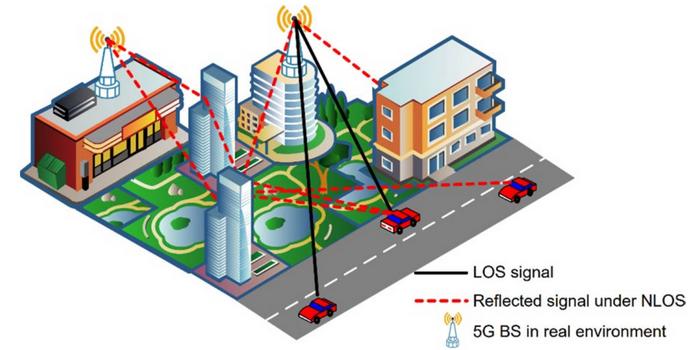In the era of smart cities and advanced mobile technologies, reliable positioning systems are becoming increasingly crucial. Amid the rapid spread of fifth-generation (5G) mobile networks, the need for precise location data intensifies, particularly in dense urban environments. However, challenges arising from high-rise buildings and other structures can severely impair signal quality, introducing non-line-of-sight (NLOS) errors that can lead to significant inaccuracies in positioning. Researchers at the Beijing Institute of Technology and China Mobile have made a remarkable breakthrough in addressing these issues by introducing a novel algorithm designed to enhance the accuracy and efficiency of 5G positioning in complex urban settings.
Understanding the necessity of reliable positioning, the team recognized that existing solutions often relied on extensive datasets or additional hardware, limiting their applicability in real-time scenarios. Traditional methods, while functional, exhibited vulnerabilities in NLOS environments—with errors often stretching to hundreds of meters. This highlighted an urgent demand for an innovative approach that could achieve accurate location tracking using solely 5G base-station data, especially in cluttered cityscapes. Addressing this challenge, the researchers developed an algorithm that incorporates virtual base-stations (VBSs) to significantly improve the precision of user location estimations.
The core mechanism of the algorithm revolves around a sophisticated combination of time-of-arrival data, particle filtering, and a statistical stability test. This multi-layered approach not only updates user location estimates more responsively but also streamlines computational processes, paving the way for real-time applications. In both controlled simulations and field tests, the algorithm has showcased a remarkable capacity to reduce positioning errors by over 21%, while also slashing computational time by nearly 77%. Such advancements signify a practical leap forward in 5G navigation capabilities, particularly in bustling urban environments.
Focusing on the algorithm’s architecture, it operates through a three-pronged design. The Time-of-Arrival (TOA) positioning model captures raw timing data from multiple base stations to cultivate an initial user location estimate. Subsequently, the virtual base-station generation component refines this estimate further by utilizing a particle filter in conjunction with a constrained random-distribution algorithm. This adaptive mechanism intelligently accommodates local signal noise, enhancing accuracy based on well-established error propagation laws.
One of the groundbreaking aspects of this approach is its use of the Augmented Dickey-Fuller (ADF) test. The ADF test, a statistical tool traditionally used in time-series analysis, is instrumental in recognizing when the algorithm’s iterative updates have reached a level of stability. This ensures that the system only executes essential updates, thereby maximizing efficiency and minimizing computational overhead. In practical applications, such as urban environments in Beijing, the algorithm yielded a staggering 21.09% improvement in positioning accuracy when juxtaposed against traditional models, distancing itself from conventional approaches like the Levenberg–Marquardt algorithm by reducing computation time significantly.
The research team grounded their findings in a desire to provide a lightweight, easily deployable solution. Lead author Song Bao emphasized the flexibility that virtual base-stations bring to existing raw 5G data configurations, allowing for enhanced signal integrity without necessitating additional infrastructure. Co-author Wang Bo expressed confidence that their innovative algorithm heralds a new frontier for location services within urban ecosystems, emphasizing its scalability and compatibility with current network architectures.
This development signals a transformative shift in the realm of urban navigation technologies. By optimizing signal accuracy without necessitating supplementary sensors or expansive data training, the virtual base-station concept integrates seamlessly into pre-existing networks. This paints a promising picture for a variety of applications, from autonomous vehicles navigating intricate urban quarters to logistics robots efficiently delivering goods and emergency responders maneuvering through challenging city layouts.
One of the notable attributes of this algorithm is its real-time capability, which supports low-latency services. This characteristic becomes paramount for applications that demand instantaneous location information, such as augmented reality experiences and integrated intelligent transportation systems. As the urban landscape continues to evolve, positioning accuracy becomes increasingly crucial for many facets of daily urban life, heralding an era where services become smarter and more responsive.
As this research progresses, future developments will aim to refine the algorithm further by incorporating a greater variety of observational data types. This effort will strive to maintain the rapid, lightweight nature of the existing architecture while enhancing its reliability across diverse urban scenarios. Ultimately, the goal is to bring high-precision 5G location services closer to becoming a ubiquitous reality in our daily lives.
In summary, the challenges posed by urban environments on 5G positioning have catalyzed significant advancements in navigation algorithms. By harnessing the power of virtual base-stations and fresh analytical methods, researchers are paving the way for more accurate and efficient location services tailored to the dynamic nature of modern cities. This breakthrough not only addresses prominent issues in positioning accuracy but also offers a scalable solution that is essential for realizing the full potential of smart city technologies in the future.
Furthermore, the algorithm’s design ensures it can adapt to evolving urban infrastructures without necessitating comprehensive overhauls to existing systems. With the ongoing development of urban environment applications, the anticipation is high for the broader implications of this research. As cities grow ever more complex, the demand for ultra-accurate, real-time location data will only continue to rise.
This exciting research, grounded in practical applications, is set to redefine urban navigation experiences and unlock new possibilities for smart city initiatives across the globe.
Subject of Research: Positioning accuracy in urban environments utilizing 5G networks
Article Title: An improved NLOS error mitigation algorithm for 5G positioning in complex urban environments
News Publication Date: 30-May-2025
Web References: Satellite Navigation
References: DOI: 10.1186/s43020-025-00165-w
Image Credits: Credit: Satellite Navigation
Keywords
Smart cities, 5G networks, positioning accuracy, virtual base-stations, NLOS errors, real-time navigation, algorithm development, urban environments, particle filtering, augmented Dickey-Fuller test.




